Computex 2006: Abit is back, Biostar expands, and Thermaltake dazzles
by Gary Key on June 10, 2006 4:00 AM EST- Posted in
- Trade Shows
Abit: Intel Motherboards
Abit is launching three different product lines this summer consisting of the Max, Fatal1ty, and Guru series. The Max series is targeting the overclocking enthusiast, Fatal1ty is for the gaming enthusiast, and Guru is the general computer user. Within the Fatal1ty series are three separate product groups based upon features and price targets; Champion, Professional, and Performance.
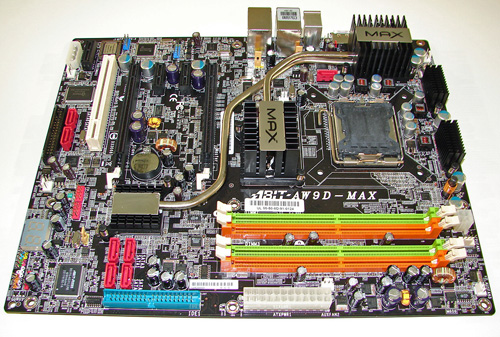
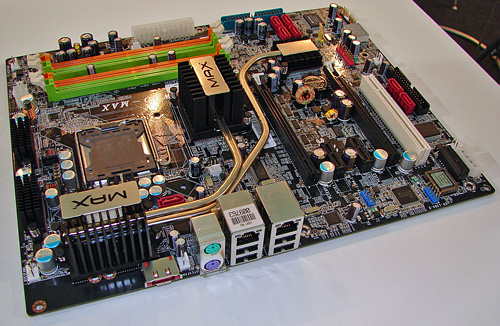
This is Abit's top of the line board featuring the Intel 975x and ICHR7 chipsets, ATI CrossFire support, silent OTES 2 cooling, OC Strips, uGuru clock, and AudioMax Technology featuring a separate riser card for the Realtek ALC882M HD codec. The memory slots will actually be colored coded black and white on the production series boards. Availability will be in early July with pricing around US $230.
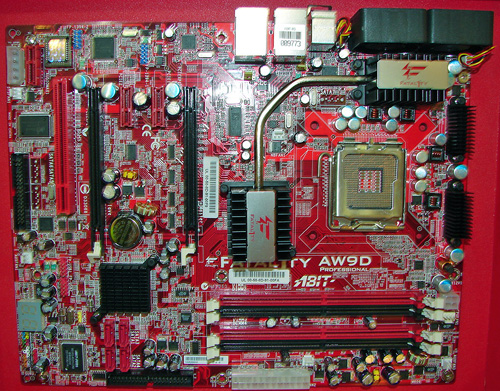
Abit's Fatal1ty Intel series features the Fatal1ty FP-A90 board with the Intel 975x and ICH7R chipsets along with Guru 2005, ATI CrossFire support, and AudioMax technology. Availability will be in July with pricing around US $215.
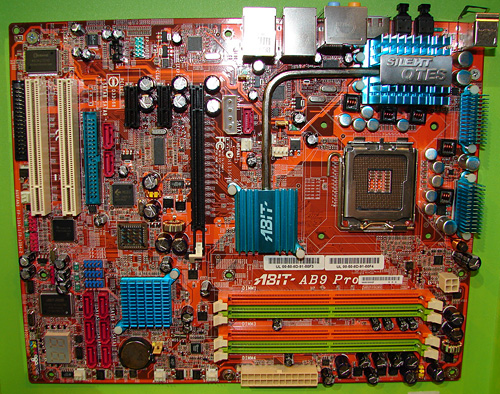
Abit's top of the line Intel 965 board is the AB9 Pro that includes two additional SATA 3Gb/s ports from a Silicon Image 3132 chipset along with one port SATA 3Gb/s and PATA (Ultra DMA 100) support from the J-Micro JMB363+ chipset. The PATA port is located in a very awkward position.
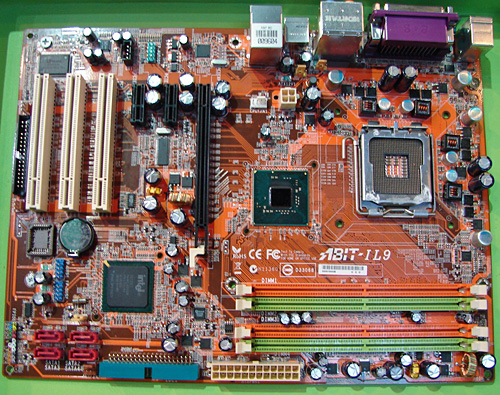
One of Abit's more budget minded Intel chipset Core 2 Duo boards will be the IL9 featuring the 946PL and ICH7 chipsets.
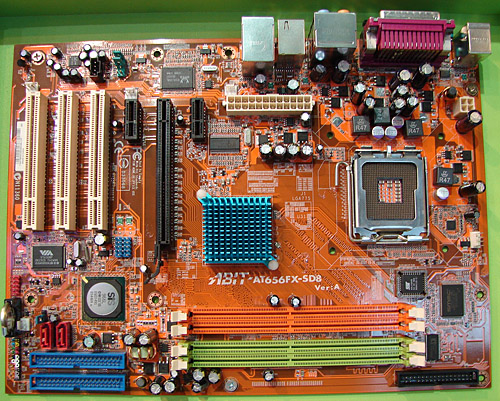
An interesting development in the low end boards that will support Core 2 Duo is the SD8 Pro that features the SIS 656 Northbridge and SIS 966L Southbridge. Expect to see this board retailing around the US $55 range and offering decent performance for a budget board.
Abit is launching three different product lines this summer consisting of the Max, Fatal1ty, and Guru series. The Max series is targeting the overclocking enthusiast, Fatal1ty is for the gaming enthusiast, and Guru is the general computer user. Within the Fatal1ty series are three separate product groups based upon features and price targets; Champion, Professional, and Performance.


This is Abit's top of the line board featuring the Intel 975x and ICHR7 chipsets, ATI CrossFire support, silent OTES 2 cooling, OC Strips, uGuru clock, and AudioMax Technology featuring a separate riser card for the Realtek ALC882M HD codec. The memory slots will actually be colored coded black and white on the production series boards. Availability will be in early July with pricing around US $230.

Abit's Fatal1ty Intel series features the Fatal1ty FP-A90 board with the Intel 975x and ICH7R chipsets along with Guru 2005, ATI CrossFire support, and AudioMax technology. Availability will be in July with pricing around US $215.

Abit's top of the line Intel 965 board is the AB9 Pro that includes two additional SATA 3Gb/s ports from a Silicon Image 3132 chipset along with one port SATA 3Gb/s and PATA (Ultra DMA 100) support from the J-Micro JMB363+ chipset. The PATA port is located in a very awkward position.

One of Abit's more budget minded Intel chipset Core 2 Duo boards will be the IL9 featuring the 946PL and ICH7 chipsets.

An interesting development in the low end boards that will support Core 2 Duo is the SD8 Pro that features the SIS 656 Northbridge and SIS 966L Southbridge. Expect to see this board retailing around the US $55 range and offering decent performance for a budget board.










27 Comments
View All Comments
Operandi - Sunday, June 11, 2006 - link
Lian Li and SilverStone need companies like Thermaltake to make ugly ass cases to make theirs look good. ;)Griswold - Saturday, June 10, 2006 - link
Or the all-time classic:Optimus Prime called, he wants his chest armor back!
Lonyo - Saturday, June 10, 2006 - link
Putting passive cooling on their "max" motherboard. It makes me sad.vailr - Saturday, June 10, 2006 - link
Only one PCI slot on Abit's "Top of the Line" board? No thanks. Would need at least 2, or preferably 3 PCI slots.And regarding the passive/heatpipe chipset cooling: these won't work with some of
the Lian-Li mid-tower cases where the motherboard is oriented "upside-down".
Chernobyl68 - Saturday, June 10, 2006 - link
That was my first thought when I started seeing all of the passive cooling solutions out there...how would it work with the Lian-Li case I plan to buy? do I need to reconsider my options? I thought all I was waiting on was an acceptable motherboard to be released before I make my new system but I may be waiting a bit longer.Chern
Gary Key - Saturday, June 10, 2006 - link
We discussed this at length with Abit, too late to change now but we told them there would be a backlash. Also, if you run CrossFire or SLI, that single PCI slot is gone.
LoneWolf15 - Saturday, June 10, 2006 - link
Major case of "Aim gun at foot, pull trigger".
Unless Abit is willing to come up with some high quality PCIe peripherals to match, their high-end single-PCI slot boards are worthless, and releasing them will be a major monetary loss. With Crossfire/SLI, this means no Creative X-Fi (or insert other better-than-onboard-sound-card here), and limited choice of any other peripherals.
Universally stupid.
JarredWalton - Saturday, June 10, 2006 - link
The only major loss is sound card support, as you can currently get Theater 550 TV Tuners in PCIe format. I'm personally finding onboard audio sufficient for my needs, especially with the latest HDA solutions. X-Fi sounds better and cleaner, but it's not something you really notice unless you have really nice speakers/headphones.It's sort of like integrated NICs - is there anyone out there that really cares about the difference between 700 Mbit vs. 950 Mbit GbE performance? The only time I touch those speeds is when doing theoretical tests; HDD speeds are the limit otherwise, and gaming? Don't make me laugh: games don't even stress a 10 Mbit Ethernet connection in most instances, and certainly don't need more than 100 Mbit.
Anyway, my point is that integrated audio is fast nearing the point where few people worry about add-in sound cards. Get some digital speakers and use the S/PDIF connections on nice motherboards, and I'd love to see some people do a "blind" listening test. I'm sort of curious about what percentage of our readers still use add-in sound cards - I would be surprised if it's more than 10%.
Odeen - Tuesday, June 13, 2006 - link
There are a few problems with onboard audio. The sound quality is one of them. The second problem is the PERFORMANCE hit and the 3d sound rendering features available.Basically, onboard audio (and outboard audio processors without hardware DS3D and EAX support can emulate EAX, but not perfectly. EAX 4.0 is a no-go at all. And this emulation is tantamount to doing software 3D rendering - it's very slow, especially when dozens of sounds need to be located in 3D space and processed.
Any gamer owes it to himself to use a sound card capable of 3D sound processing, or they're cheating themselves out of frame rates.
BPB - Saturday, June 10, 2006 - link
Did they really think that people running Crossfire setups wouldn't at least want better-than-onboard sound? That alone is one PCI slot. The onboard sound looks good, but is it that good?